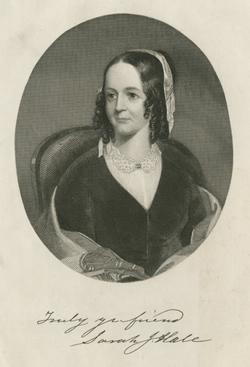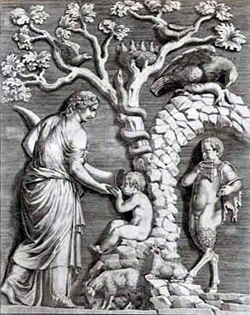1. The Origins of Thanksgiving
 Thanksgiving was not started by the Pilgrims as we have popularly believed, but instead by another group from England, the Puritans. The historical documents to demonstrate the true origins of Thanksgiving are starting to become more accessible thanks to the internet, the Library of Congress and Google Books. But the most accurate and complete description of the true historical origins of Thanksgiving in one place are written by James Baker, historical author and researcher, former senior historian of the Plimoth Plantation and curator of the Alden House Historic Site.
Thanksgiving was not started by the Pilgrims as we have popularly believed, but instead by another group from England, the Puritans. The historical documents to demonstrate the true origins of Thanksgiving are starting to become more accessible thanks to the internet, the Library of Congress and Google Books. But the most accurate and complete description of the true historical origins of Thanksgiving in one place are written by James Baker, historical author and researcher, former senior historian of the Plimoth Plantation and curator of the Alden House Historic Site.
The popular perception of America’s Thanksgiving holiday might be summed up as “it all began with the Pilgrims.”... The “First Thanksgiving” is an etiologic tale, a story told to explain and define the holiday through an account of its alleged origins.
The American Thanksgiving Holiday
James Baker
Below is James Baker's article "The American Thanksgiving Holiday" which is an absolute must read to really understand the history of Thanksgiving.
2. The Truth about Thanksgiving Day
"The reason that we have so many myths associated with Thanksgiving is that it is an invented tradition. It doesn't originate in any one event. It is based on the New England puritan Thanksgiving, which is a religious Thanksgiving, and the traditional harvest celebrations of England and New England and maybe other ideas like commemorating the pilgrims. All of these have been gathered together and transformed into something different from the original parts."
James W. Baker, Senior Historian at Plimoth Plantation
If you've grown up in the United States, undoubtedly you've experienced the euphoria of the Thanksgiving meal and celebration. Just like Christmas, it can be an amazing and joyous time with family and good food. Most likely you were taught that Thanksgiving was started by the “Pilgrims”, some of the first settlers to America. The traditional story begins with a treacherous Atlantic crossing on the Mayflower, and after the Pilgrims landed, they were helped by local Indians. Then later, after a good harvest, the Pilgrims invited the Indians to the first Thanksgiving. The problem with the traditional Thanksgiving story is that it's a myth. The primary myth being that the Pilgrims started Thanksgiving.
3. Why the Pilgrims? Mythology and Thanksgiving Day
1. a traditional or legendary story, usually concerning some being or hero or event, with or without a determinable basis of fact or a natural explanation,
...
5. an unproved or false collective belief that is used to justify a social institution.
Dictionary.com Unabridged (v 1.1)
4. Defining Thanksgiving Day. What is it?
THANKSGIVING DAY, in the United States, the fourth Thursday in November, annually set apart for thanksgiving by proclamation of the president and of the governors of the various states. The day is observed with religious services in the churches, and, especially in New England, as an occasion for family reunion.
Encyclopedia Britannica 11th edition, 1911
5. Thanksgiving vs thanksgiving, The Thanksgiving Dichotomy
For well over a century, Thanksgiving has been an annual national observance. The origin and significance of any celebration can easily become obscured over such a long period. So, while Thanksgiving Dinners bring families and friends together all over our country, the richness of the holiday's history is often ignored.
Celebrate Thanksgiving, Jay J. Harris
6. Religious Thanksgiving Proclamations
 Almost every thanksgiving proclamation that could be found regarded the day to be religious either in it's entirety or in some related manner. Starting from the beginnings of the colonies to this past year.
Almost every thanksgiving proclamation that could be found regarded the day to be religious either in it's entirety or in some related manner. Starting from the beginnings of the colonies to this past year....prostrate themselves jointly before God for the obtaining of the Lords gracious expression... That a spirit of conversion be poured upon our Children, that they may give up themselves and their Seed after them to be the Lords...1
General Court, Boston, New England 1678
7. Religious oppression and the political landscape
The confusion which has arisen between two very distinct religious parties, who took part in the early colonization of New England—the Separatist " Pilgrim Fathers " of New Plymouth, and the Puritan Fathers who subsequently colonized Massachusetts, has been occasioned by careless historians,
The Pilgrim Fathers Neither Puritans Nor Persecutors, Benjamin Scott, 1866
8. The Founding Fathers and an end to government Thanksgiving
 The Bill of Rights did not immediately stop religious persecution in America. Over ten years later the issue arose in an unusual way. The phrase “separation of church and state” came from a letter Jefferson wrote in response to a request from the Danbury Baptists of Connecticut seeking relief from religious oppression in 1801.
The Bill of Rights did not immediately stop religious persecution in America. Over ten years later the issue arose in an unusual way. The phrase “separation of church and state” came from a letter Jefferson wrote in response to a request from the Danbury Baptists of Connecticut seeking relief from religious oppression in 1801.
Jefferson was accused of being an atheist (a politically dangerous stigma) because of a number of his beliefs and actions. One of these was that he refused to proclaim days of fasting or thanksgiving. Levi Lincoln, the US Attorney General at the time, was a man he trusted to advise him on how to deal with his reply to the Danbury Baptists, while at the same time making a public response to criticism of his religious positions. Here is part of their correspondence on this issue.
9. Sarah Hale, The Mother of Thanksgiving

Illustration 8: Sarah Josepha Hale
(1788-1879)
Thanksgiving has a rich and complicated history, but at the core of our modern Thanksgiving Day is Sarah Hale, without her influence we would likely not have Thanksgiving Day. Sarah had a difficult and trying life. She had lost her husband and had 5 children to feed, (all of them 7 years or younger) so she earned money by writing. Her first major success was a book titled Northwood. Which had an entire chapter dedicated to a Thanksgiving at the protagonist's house. Another of Hale's noteworthy additions to American culture is the poem Mary Had a Little Lamb. Sarah Hale has had significant influence on the social life of Americans.
She campaigned relentlessly for a national Thanksgiving for almost 40 years. Writing thousands of letters to state and territory governors to proclaim Thanksgiving Day on the last Thursday of November. She was so influential that she has been given credit for single-handedly convincing President Lincoln in 1863 to produce the first presidential thanksgiving proclamation in the unbroken tradition of observance.
10. Sarah Hale's Thanksgiving campaign
Below are excerpts from some of the relevant articles she wrote relating to Thanksgiving. All emphasis in the quotes are from Sarah Hale.
1837
This may be the first writings Sarah Hale did for the Lady's Book regarding Thanksgiving. She starts her campaign off with God's Holy days.
The noble annual feast day of our Thanksgiving resembles, in some respects, the Feast of Pentecost, which was, in fact, the yearly season of Thanksgiving with the Jews. ... induce all the states to join in the commemoration of "In-gathering," which it celebrates. It is a festival which will never become obsolete,
Sarah Hale, Godey's Lady's Book 1837
11. Why the “last Thursday of November�
“The last Thursday in November was suggested because then the agricultural labors of the year are generally completed; the elections are over; those autumnal diseases which usually prevail more or less at the South have ceased, and the summer wanders are gathered to their homes.”
Sarah Hale, Godey's Lady's Book 1863
12. When did Thanksgiving Day become a national legal holiday?

Illustration 9: H.J. RES 41, Congressional act that set the 4th Thursday of November as Thanksgiving Day.
JOINT RESOLUTION
Making the fourth Thursday in November a legal holiday.
Resolved by the Senate and House of Representatives of the United States of America in Congress assembled, That the fourth Thursday of November in each year after the year 1941 be known as Thanksgiving Day, and is hearby made a legal public holiday to all intents and purposes and in the same manner as the 1st day of January, the 22nd day of February, the 30th day of May, the 4th day of July, the first Monday of September, the 11th day of November, and Christmas Day are now made by law public holidays.
Passed the House of Representatives October 6, 1941.
archives.gov/legislative/features/thanksgiving/
13. Is Thanksgiving Day Holy?
1. legal day off: a day set aside by law or statute as exempt from regular labor or business activities, usually to celebrate or commemorate something that happened on or near that date
a public holiday
2. holy day: the day or days of a religious festival
Besides the Sabbath, [New Haven Colonists in 1643] recognize but two holy days throughout the year, the Fast Day in the Spring, and the Thanksgiving Day in the Autumn.
The Christian Recorder, January 1866
...consecrate the last Thursday in the month
Sarah Hale, Godey's Lady's Book 1861
Christians of any nation or creed could meet together, this happy, hallowed festival
Sarah Hale, Godey's Lady's Book 1861
14. The Pilgrim leaders on religious anniversaries and holy days
We popularly perceive that everyone in the colonies was of the same mind religiously, but this was not so from the very beginning. It's commonly known that the Pilgrims and Puritans did not keep Christmas. But is there more to this story than we realize? What is their logic for not observing it? Does it apply to Thanksgiving Day? How pervasive was the desire in the early colonies to observe pagan holidays?
15. Holy Days or Holidays?
What About National Holidays Like Thanksgiving, Purim and Hanukkah?
Since so many religious holidays have pagan roots, are all modern holidays suspect? What about national holidays such as Thanksgiving in the United States and Canada, and the Jewish national holidays of Purim and Hanukkah?
...
Both of these holidays [Purim and Hanukkah] were established to give thanks to God, just as the American and Canadian Thanksgiving days are. Though some modern customs of these days may not be pleasing to God, they are not rooted in paganism and do not subvert any of the truths presented in the festivals of God.
From Holidays to Holy Days: God's Plan for You, COGWA Booklet
16. The Cornucopia

Illustration 12: Amalthea feeds Zeus from the horn
Just like Christmas and Easter, Thanksgiving has one major pagan symbol, the cornucopia. But unlike the Christmas tree or the Easter bunny, the cornucopia is linked directly to both Greek and Roman pagan Gods. There is a plethora of evidence that supports the fact that the cornucopia was in frequent use and display during Christ's time on earth, and it's unlikely that the cornucopia would have mistaken for anything but a pagan symbol.It is the proud symbol of the nation's prosperity and good fortune.
Federal Reserve Bank of San Francisco